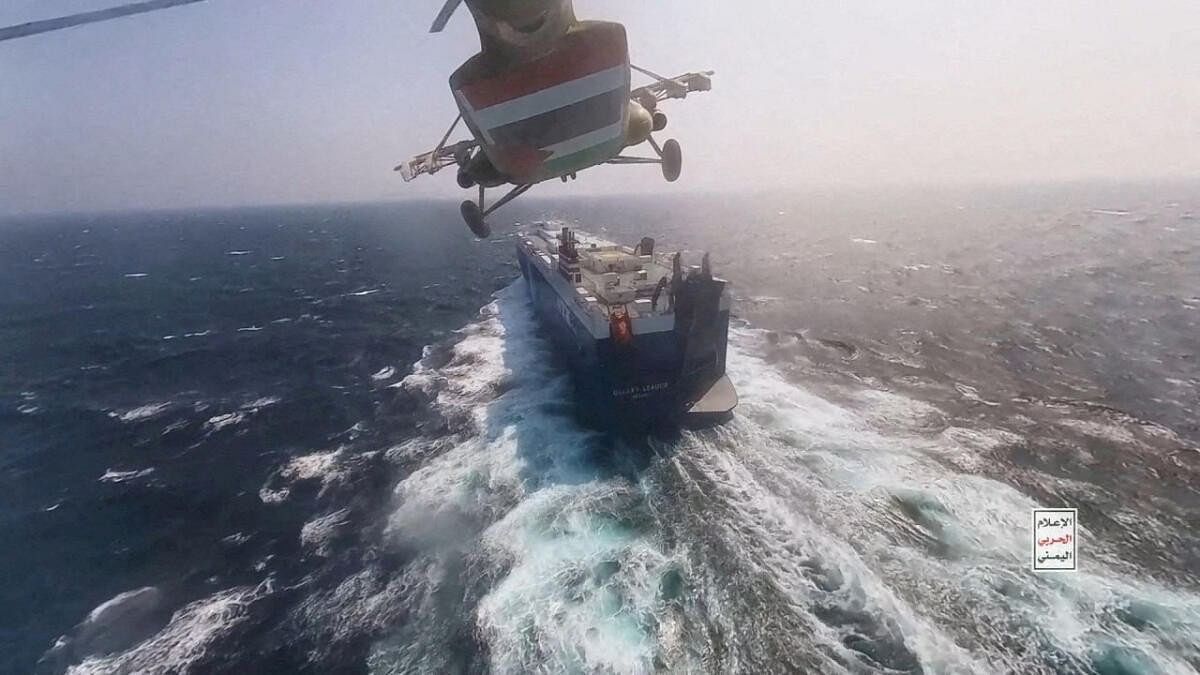
Houthi military helicopter flies over the Galaxy Leader cargo ship in the Red Sea.
Credit: Reuters Photo
London: Yemen's Houthis have been targeting vessels in the southern Red Sea and the Bab al-Mandab Strait in attacks that the Iran-aligned group says aim to support the Palestinians as Israel and Hamas wage war.
The attacks have disrupted global trade flows, with shipping firms and oil companies saying they would avoid the Suez Canal, adding to freight costs and making voyages longer as vessels opt to circumnavigate the African continent instead.
Why are the Houthis attacking ships?
* The attacks are in support of the Palestinian Islamist group Hamas fighting Israel in the Gaza Strip.
* The Gaza war has drawn in the United States and its allies on the side of Israel, and Iran and its Arab proxy forces on the side of Hamas, raising the risk of a wider Middle East conflict.
* The Houthis, who control most of Yemen, said they will target all ships heading to Israel, regardless of their nationality, and warn all international shipping companies against dealing with Israeli ports.
What ships have the Houthis targeted?
* Dec. 18: The M/V Swan Atlantic is attacked in the southern Red Sea by multiple projectiles launched from Houthi-held territory, US officials told Reuters.
* Dec. 16: the U.S. Central Command says its guided missile destroyer USS Carney (DDG 64) shot down 14 drones launched by Houthis over the Red Sea.
* Dec. 15: A projectile launched from Houthi-controlled Yemen strikes the Liberia-flagged, German-owned Al Jasrah ship, causing a fire but no injuries, a US defence official says.
* Dec. 15: Maersk denies a Houthi claim that the militia carried out a drone strike on a Maersk vessel sailing towards Israel, but says the tanker was targeted by a missile. Shipping sources say that vessels operated by Maersk Tankers have the option to re-route via the Cape of Good Hope at the southern tip of Africa due to the worsening security situation in the Red Sea.
* Dec. 12: Houthi spokesman says the group targeted the Norwegian commercial tanker STRINDA. The attack occurred about 60 nautical miles (111 km) north of the Bab al-Mandab Strait at about 2100 GMT, a U.S. official tells Reuters.
* Dec. 10: A French warship operating in the Red Sea shoots down two drones launched at it from the Yemen coast, the defence ministry says.
* Dec. 3: The US military says three commercial vessels came under attack in international waters in the southern Red Sea; Houthis claimed drone and missile attacks on two Israeli vessels in the area.
* Nov. 19: Israel says Houthis seized a British-owned and Japanese-operated cargo ship in the southern Red Sea.
What is the Bab al-Mandab and why is it important?
* Bab al-Mandab, or the Gate of Tears, named for its perilous navigation conditions, is the southern outlet of the Red Sea, situated between Yemen on the Arabian Peninsula and Djibouti and Eritrea on the African coast.
* It is one of the world's most important routes for global seaborne commodity shipments, particularly crude oil and fuel from the Gulf bound for the Mediterranean via the Suez Canal or the SUMED pipeline on Egypt's Red Sea coast, as well as commodities bound for Asia, including Russian oil.
* The Bab al-Mandab was the site of a naval blockade of Israel by Egypt in the 1973 Yom Kippur War.
* The Bab al-Mandab is 18 miles (29 km) wide at its narrowest point, limiting traffic to two channels for inbound and outbound shipments, divided by the island of Perim.
* Around 7.80 million barrels per day of crude and fuel shipments transited the strait in the first 11 months of 2023, up from 6.60 million bpd throughout 2022, according to oil analytics firm Vortexa. On average, Vortexa tracked 27 tankers carrying crude or fuel each day in 2023, up from 20 last year.
* According to the Energy Information Administration, 12 per cent of total seaborne-traded oil in the first half of 2023 as well as 8 per cent of LNG trade passed through the Bab al-Mandab, the SUMED pipeline and the Suez Canal.
How have the attacks impacted global trade?
* Major shippers including Hapag Lloyd, MSC and Maersk, oil major BP and oil tanker group Frontline have said they will be avoiding the Red Sea route and re-routing via the Cape of Good Hope for the time being.
* A number of container ships are anchored in the Red Sea and others have turned off tracking systems as traders adjust routes and prices in response to the attacks.
What measures are being taken to protect ships?
* Defense Secretary Lloyd Austin on Dec. 19 said the United States was leading a multinational operation to safeguard commerce in the Red Sea.
* He said the United Kingdom, Bahrain, Canada, France, Italy, the Netherlands, Norway, Seychelles and Spain were among nations involved in the Red Sea security operation, which will be known as "Operation Prosperity Guardian".
* Sources told Reuters, however, that Saudi Arabia - seeking to contain spillover from the Hamas-Israel war - has asked the United States to show restraint in responding to attacks in the Red Sea.
* The international community has had a history of using naval forces to protect navigation from piracy off the Horn of Africa, especially as Somali piracy surged in the 2005-2011 period.
* In December 2008, the European Union launched "Operation Atalanta" to tackle Somali attacks on cargo ships. NATO's Operation Ocean Shield, as well as a multinational naval force known as Combined Task Force 151, have also been involved in anti-piracy protection.